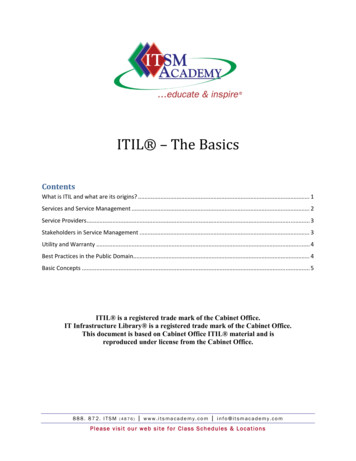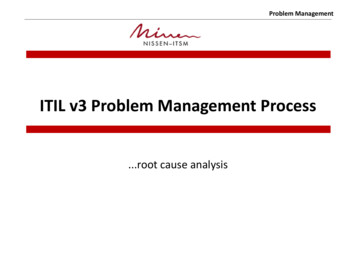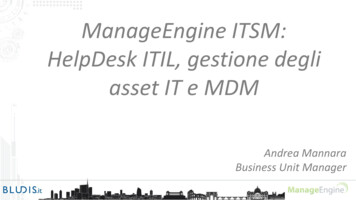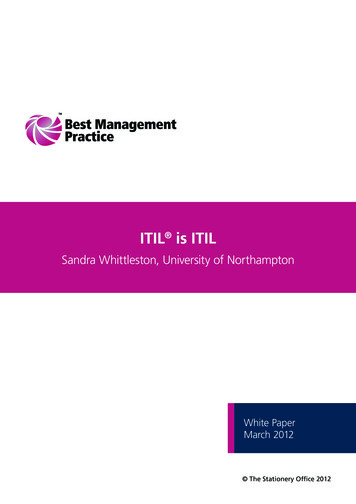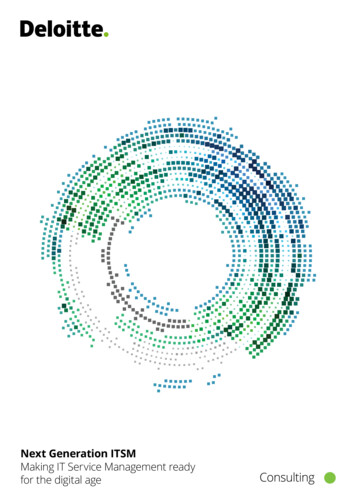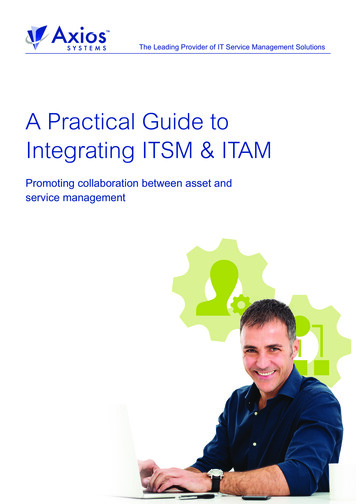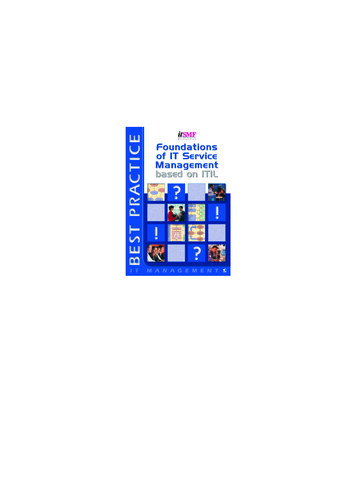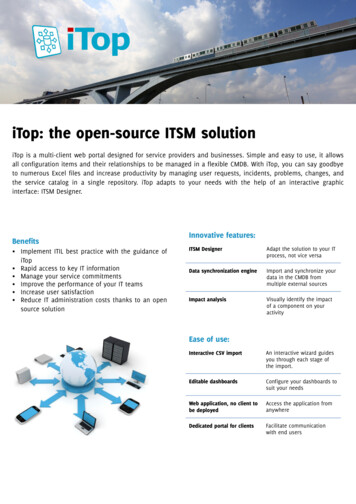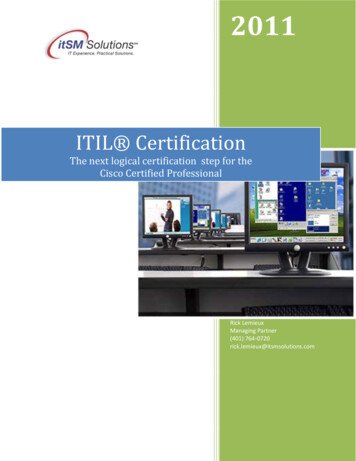
Transcription
2011ITIL CertificationThe next logical certification step for theCisco Certified ProfessionalRick LemieuxManaging Partner(401) 764-0720rick.lemieux@itsmsolutions.com
ContentsIT Transformation . 3IT’s New Operating Model . 4IT Frameworks, Methods & Standards . 4ITIL and the Cisco Certified Professional. 5ITIL Certifications . 6ITIL Foundation Certification. 6ITIL Lifecycle Certification . 6ITIL Capability Certification . 6ITIL Managing Across the Lifecycle Expert Certification . 7ITIL V2 to V3 Service Manager Bridge . Error! Bookmark not defined.ITIL Exams. 7ITIL Foundation Exam. 7ITIL Lifecycle, Capability and Managing Across the Lifecycle Exams . 7ITIL V3 Class & Exam Specifications . 8ITIL Certification Roadmap & Credit Profiler . 9
IT TransformationTwo things are certain: first, IT is now at the center of most businesses; second, business is a movingtarget. The demand for coordination across value chains, functions, markets, and geographies willcontinue to accelerate, and it will be impossible to respond to this challenge without driving new waysof thinking through corporate ranks.Information technology is fundamental to corporate success, and IT decisions, like all other businessdecisions, must consider the value of its contribution to the business. In light of this, a solid, soundbusiness case for IT investments requires mature IT and business judgment. Unfortunately, there are noshortcuts to developing maturity or to developing judgment - both take time and experience. There isonly one way to gain traction in these circumstances and that is to apply the collective experience ofboth IT and business people to the pursuit and execution of a single corporate strategy. In this case theintegrated whole is definitely much greater than the sum of the two parts.Successful IT/business alignment means developing and sustaining a symbiotic relationship between ITand business – a relationship that benefits both parties. This requires that the business recognize ITexecutives as essential to the development of credible business strategies and operations, and that ITconsider non-IT executives equally essential to the development of credible IT strategies and operations.In order to support this new IT/business model, IT needs to transform the traditional Business - ITparadigm from one focused on technological value to one focused on service value. This service providerparadigm encompasses IT best practices using the perspectives of people, process, technology,organization, and integration. The following attributes depict the transformation of a traditional“business - IT paradigm”:Traditional I/TbecomesService Focused - ITTechnology Focus Process Focus"Fire-Fighting" PreventativeReactive ProactiveUsers CustomersCentralized, Done In-House Multi-SourcedIsolated, Silos Integrated, Enterprise-Wide"One Off", Ad Hoc Repeatable, AccountableInformal Processes Formal Best PracticesIT Internal Perspective Business PerspectiveOperational Specific Service Orientation
IT’s New Operating ModelIn order to operate as a service provider, IT organizations must demonstrate three main characteristics;an unambiguous understanding of their customer’s need, repeatable processes to ensure consistency ofexecution, and the ability to innovate in a structured manner. In effect this becomes the model for thedelivery of business aligned-processes and technology.In order to achieve an unambiguous understanding of the customer’s needs, the service provider must,in a structured repeatable manner, define and categorize the enterprise process, technology andcapability requirements. The next step is to compare these requirements to the existing environment tounderstand what it will take to achieve and manage the required capability. The provider must do this inthe context of governance based on enterprise goals and achievement measured against expectedoutcomes.Repeatable processes are required to ensure consistency of execution. This is critical because day-to-daybusiness processes rely so much on embedded technology that failure to execute consistently directlyimpacts the enterprise’s ability to deliver its product or service.Finally, the service provider must develop a utility grade delivery platform and process managementmodel that is capable of supporting emerging utility based architectures and applications such as RealTime Infrastructure (RTI), Service Oriented Architecture (SOA) and Software as a Service (SaaS). A serviceprovider provides the portal through which the enterprise receives its enabling business technology. Theservice provider brokers those services irrespective of their source, internal or external. Therefore, theprovider can deliver utility grade, enterprise-aligned services as needed, and manage technologyinvestments and innovation in a structured manner. Underpinning all of this is the need for a model thathelps identify what services need to be sourced internally and what services can be sourced externally.This model will provide the guidance the enterprise needs to classify the services and processes that arecritical to quality service delivery and differentiation in the marketplace.IT Frameworks, Methods & StandardsIn order to support this new operating model, IT needs to transform the traditional Business – ITparadigm from one focused on technological value to one focused on service value. This service providerparadigm encompasses widely accepted IT best practices frameworks, methods and standards using theperspectives of people, process, technology, organization, and integration.According to the official ITIL site (www.itil-officialsite.com), ITIL is the only consistent andcomprehensive documentation of best practice for IT Service Management. Used by thousands oforganizations around the world, a whole ITIL philosophy has grown up around the guidance containedwithin the ITIL books and the supporting professional qualification scheme.ITIL consists of a series of books giving guidance on the provision of quality IT services, and on theaccommodation and environmental facilities needed to support IT. ITIL has been developed inrecognition of organizations growing dependency on IT and embodies best practices for IT ServiceManagement.
The ethos behind the development of ITIL is the recognition that organizations are becomingincreasingly dependent on IT in order to satisfy their corporate aims and meet their business needs. Thisleads to an increased requirement for high quality IT services.ITIL is supported by a comprehensive qualification scheme along with a network of accredited training,consulting and technology providers operating across the globe.The primary benefit coming out of most ITIL projects is a significant reduction in IT's Total Cost ofOwnership (i.e., operations cost) along with the ability to deliver reliable, high value services to theirclient base. Today, ITIL best practices have been adopted by organizations of all sizes including Disney,IBM, Caterpillar, Shell Oil, Boeing and governments across the globe.The five Books of ITIL are: Service Strategy - Guidance, clarification & prioritization of investments in direct and 3rd partyservice provider services. Focus areas include - Portfolio Management, Financial Management &Demand Management. Service Design - Guidance on producing & maintaining IT policies, architectures, & documents tosupport the design of innovative service solutions and processes. Focus areas include - ServiceCatalog Management, Service Level Management, Capacity Management, AvailabilityManagement, Continuity Management, Information Security Management & SupplierManagement. Service Transition - Guidance & process activities for transitioning services into the operationalenvironment. Focus areas include - Transition Planning & Support, Change Management, ServiceAsset & Configuration Management, Release & Deployment Management, Service Validation &Testing, Evaluation & Knowledge Management. Service Operation - Guidance on delivery and control activities to achieve operationalexcellence on a day-to-day basis. Focus areas include - Event Management, IncidentManagement, Fulfillment Management, Problem Management, Access Management, ServiceDesk, Technical Operations & Application Management. Continual Service Improvement - Guidance on aligning & realigning IT Services to changingbusiness needs by identifying & implementing improvements. Focus areas include - IT ServiceManagement, IT Governance, IT Resource Management, IT Security Management & IT QualityManagement.ITIL and the Cisco Certified ProfessionalITIL and other best practice certification has become a virtual requirement for IT professionals looking tosurvive or grow within this new world of service focused IT. Both commercial and government ITorganizations now expect IT professionals to not only have a “technology certification” but also a seriesof soft skill certifications (i.e., ITIL, CobiT etc.) that will enable them to operate using the best practiceprocedures and support structures outlined in ITIL and other frameworks, methods and standards . The
chart below aligns your existing Cisco Certification with its corresponding ITIL Certification to ensure thatyour certification portfolio projects a balance of technology and best practice certifications for the ITareas you are responsible for.CiscoRole in the ITPotential PCCSPCCIPCCDACCNACCENTArchitech - Cisco Network SolutionsExpert - In a Cisco Practice AreasExpert - Designing Cisco NetworksProfessional - Designing Cisco NetworksProfessional - In a Cisco Network Practice AreaProfessional - Cisco SecurityProfessional - Service ProvidersAssociate - Designing Cisco NetworksAssociate - In a Cisco Practice AreaEntry Level - Cisco ProfessionalExpert - ITSM Lifecycle DesignExpert - ITSM Lifecycle DesignExpert - ITSM Lifecycle DesignPractitioner - ITSM DesignPractitioner - ITSM OperationsPractitioner - ITSM OperationsPractitioner - ITSM OperationsAssociate - ITSM DesignAssociate - ITSM OperationsEntry Level - ITSM ProfessionalITIL Certification Path for Cisco Certified onFoundationFoundationITIL Lifecycle Certification ClassesStrategyStrategyStrategyStrategyDesign Transition OperationDesign Transition OperationDesign Transition OperationDesignITIL Capability ClassesCSICSICSICSICSICSICSICSICSIExpert CapstoneMALCMALCMALCC-OSAC-RCVC-OSAC-RCVC-PPOAlso listed below are the details behind the ITIL programs listed in the chart above.ITIL CertificationsITIL Foundation CertificationThe foundation-level certification program targets IT professionals looking to become a generalpractitioner in the practice of IT Service Management. While these practitioners have a generalunderstanding of ITSM, they have a limited knowledge of any specific process, function or servicelifecycle area. This is also the first stop for those looking to become ITSM Specialists, ITSM PracticeManagers or ITSM Expert.ITIL Lifecycle CertificationThe lifecycle certification series targets individuals looking to specialize in one or more of the five ITILLifecycle Planning Practice Areas. Historically, these roles comprise individuals who are responsible forthe Planning, Design and Optimizing (improvement) areas within the IT Engineering, ApplicationDevelopment, Security and Project/Program Management organizations. In order to take thecertification examination for any of these Lifecycle courses, you must hold an ITIL V3 Foundationcertificate.Lifecycle certification classes include: Service Operation (SO), Service Transition (ST), Service Design(SD), Service Strategy (SS) and Continual Service Improvement (CSI).ITIL Capability CertificationThe capability certification series targets individuals looking to specialize in one or more of the four ITILCapability Operational Practice Areas. Historically, these roles include individuals who are responsiblefor the Operations (service maintenance & support) areas within the IT Implementation and Operationsorganizations. In order to take the certification examination for any of these Lifecycle courses, you musthold an ITIL V3 Foundation certificate.Capability certification classes include: Operational Support & Analysis (OSA), Release, Control &Validation (RCV), Plann
hold an ITIL V3 Foundation certificate. Capability certification classes include: Operational Support & Analysis (OSA), Release, Control & Validation (RCV), Planning, Protection & Optimization (PPO), Service Offerings & Agreements (SOA). ITIL Managing Across the Lifecycle Expert Certification The Managing Across the Lifecycle (MALC) program leads to the ITIL V3 Service Manager Expert .

